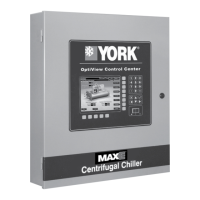338
FORM 160.54-M1
ISSUE DATE: 10/25/2019
SECTION 36 - SOFTWARE ENHANCEMENTS
JCI COMPANY CONFIDENTIAL JOHNSON CONTROLS
CHILLER MOD –
COMPRESSOR
PROXIMITY
SENSE
OIL
HEATER
OUTPUT*
LEVEL
CONTROL
PERIOD
DEFAULT
FLOW SWITCH
OIL-VARIABLE SPEED
PUMP PRESSURE SETPOINT
NOT ACHIEVED
THRESHOLD*
Mod C, D, E –
G, H, J Compr
Probe TB1-34 3.5 sec Paddle Type 35 psid
Mod E – P Compr Limit Switch TB1-64 10.0 sec Paddle Type 25 psid
Mod F – G, H
Compr
Limit Switch TB1-64 3.5 sec
Factory Mounted
Thermal Type
35 psid
Mod F – J Compr Probe TB1-64 3.5 sec
Factory Mounted
Thermal Type
35 psid
Mod F – P, Q
Compr
Limit Switch TB1-64 10.0 sec
Factory mounted
Thermal Type
25 psid
* Not applicable to Mod C (and earlier) chillers.
SI0034 - SOFTWARE ENHANCEMENTS EFFECTIVE AUGUST 2002 (CONT'D)
FACTORY MOUNTED FLOW SENSORS
Style F (and later) chillers are supplied with factory-
mounted flow sensors on the evaporator and condens-
er. These are electronic thermal-type sensors. The op-
erating principle of the sensor is thermal conductivity.
It uses the cooling effect of a flowing liquid to sense
flow. The temperature of the heated sensor tip is sensed
by a thermistor located in the tip.
A second thermistor, located higher in the tip in a non-
heated area, is only affected by changes in liquid tem-
perature. The temperatures sensed by the thermistors
are compared. Flowing liquid carries heat away from
the heated sensor tip, lowering its temperature. The
lower temperature differential between the two therm-
istors indicates the liquid is flowing. A higher differen-
tial indicates no flow. Each device operates from a 24
VAC power source and has a solid state relay output.
On each sensor, one side of the solid state relay output
(pin 2) is connected to the microboard +5 VDC and the
other side (pin 4) is connected to a Microboard Analog
Input.
When flow is sensed, the solid state relay output is
turned on causing it to conduct current through the
7.5K ohm microboard load resistor to the +5 VDC.
This applies more than +4 VDC to the microboard in-
put (evaporator J7-14; condenser J7-16). When no flow
is sensed, the solid state relay output is turned off, re-
sulting in no conduction through the load resistor. This
applies less than 1 VDC to the microboard input. To
determine the state of the solid state relay, first confirm
that +5 VDC is present at pin 2 of the flow sensor. Then
connect a voltmeter from Microboard J7-14 (evapora-
tor) or J7-16 (condenser) to Microboard TP1 (ground).
The power source is connected to the sensor as follows:
From To
Sensor pin 1 TB1-162 (24 VAC)
pin 3 TB6-5 (GND)
The sensor outputs are connected to the microboard as
follows:
Evaporator:
From To
Sensor pin 2 Microboard J7-1 (+5 VDC)
pin 4 J7-14 (input to Microboard )
Condenser:
From To
Sensor pin 2 Microboard J7-15 (+5 VDC)
pin 4 J7-16 (input to Microboard)

